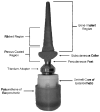Percutaneous osseointegrated prostheses for amputees: Limb compensation in a 12-month ovine model
- PMID: 21920525
- PMCID: PMC3190641
- DOI: 10.1016/j.jbiomech.2011.08.020
Percutaneous osseointegrated prostheses for amputees: Limb compensation in a 12-month ovine model
Abstract
Percutaneous osseointegrated prostheses are being investigated as an alternative strategy to attach prosthetic limbs to patients. Although the use of these implants has shown to be promising in clinical trials, the ability to maintain a skin seal around an osseointegrated implant interface is a major challenge to prevent superficial and deep periprosthetic infections. The specific aim of this study was to establish a translational load-bearing ovine model to assess postoperative limb compensation and gait symmetry following a percutaneous osseointegrated implant. We tested the following hypotheses: (1) the animals would return to pre-amputation limb loads within 12-months; (2) the animals would return to a symmetrical gait pattern (stride length and time in stance) within 12-months. The results demonstrated that one month following surgery, the sheep loaded their amputated limb to a mean value of nearly 80% of their pre-amputation loading condition; by 12-months, this mean had dropped to approximately 74%. There was no statistical differences between the symmetry of the amputated forelimb and the contralateral forelimb at any time point for the animals stride length or the time spent in the stance phase of their gait cycle. Thus, the data showed that while the animals maintained symmetric gait patterns, they did not return to full weight-bearing after 12-months. The results of this study showed that a large animal load-bearing model had a symmetric gait and was weight bearing for up to 12 months. While the current investigation utilizes an ovine model, the data show that osseointegrated implant technology with postoperative follow-up can help our human patients return to symmetric gait and maintain an active lifestyle, leading to an improvement in their quality of life following amputation.
Published by Elsevier Ltd.
Conflict of interest statement
Conflict of Interest Statement The authors have no conflict of interest associated with this study.
Figures




References
-
- M M a M W R. Vol. 47. CDC US Department of Health and Human Services, MMWR; Atlanta, GA: 1998. Diabetes-related amputations of lower extremities in the Medicare population - Minnesota 1993-1995; pp. 649–664. - PubMed
-
- M M a M W R. Vol. 50. CDC US Department of Health and Human Services, MMWR; Atlanta, GA: 2001. Hospital discharge rates for nontraumatic lower extremity amputation by Diabetes status - United States, 1997; pp. 954–958. - PubMed
-
- D o D T. CDC National Center for Chronic Disease Prevention and Health Promotion, CDC; Atlanta, GA: 2011. National Diabetes fact sheet, 2011; pp. 1–12.
-
- Aamodt A, Lund-Larsen J, Eine J, Andersen E, Benum P, Husby OS. Changes in proximal femoral strain after insertion of uncemented standard and customised femoral stems. An experimental study in human femora. J Bone Joint Surg [Br] 2001;83-B(6):921–929. - PubMed
-
- Albrektsson T, Branemark I-I, Hansson H-A, Lindstrom J. Osseointegrated titanium implants. Acta Orthop Scand. 1981;52(2):155–170. - PubMed
Publication types
MeSH terms
Grants and funding
LinkOut - more resources
Full Text Sources

